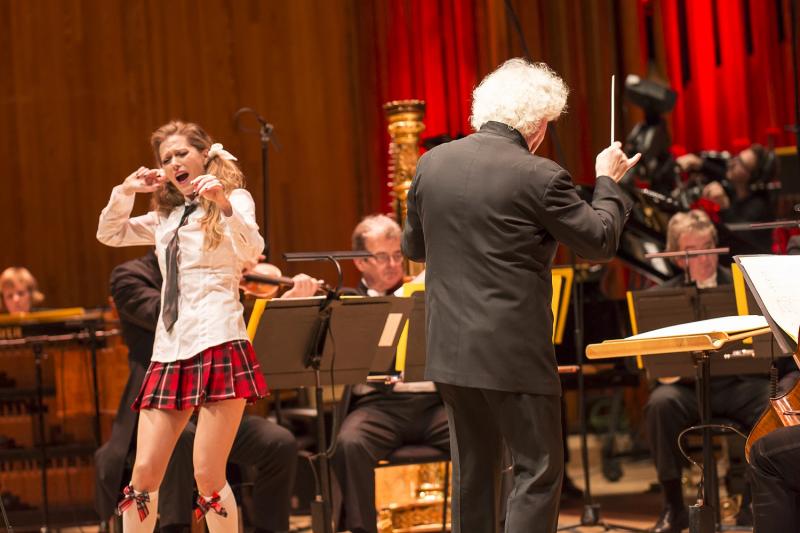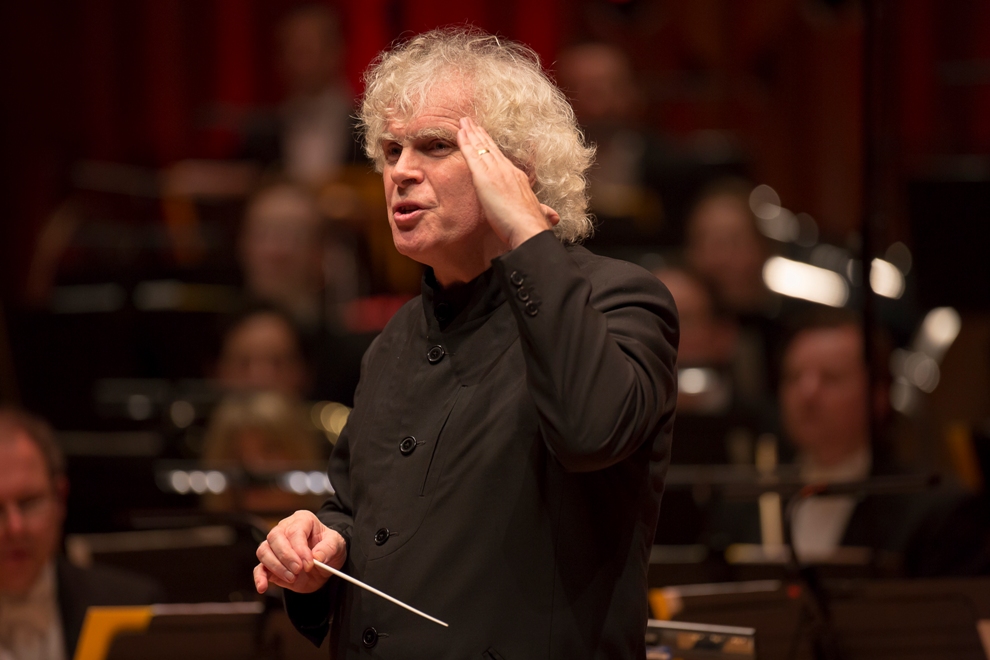Hannigan, LSO, Rattle, Barbican Hall | reviews, news & interviews
Hannigan, LSO, Rattle, Barbican Hall
Hannigan, LSO, Rattle, Barbican Hall
Heroines and hysterics with Stravinsky, Ligeti, Berg and Webern

For his second programme this week with the London Symphony Orchestra, Sir Simon Rattle conducted variations on a programme he’s been doing for years. So what’s the theme? Invention and hysteria, you might say. Berg’s Marie in Wozzeck and Stravinsky’s virgin in The Rite of Spring both meet gory if wordless ends.
Rattle has repeatedly gone on record to disparage the Barbican’s acoustics, and his Sunday concert of Schumann’s Paradise and the Peri felt at points restrained and yet constrained, as though a much bigger sound was struggling to get out. The numbed processional at the heart of Webern’s Op.6 suffered from the same problem (as it had done when he and the Vienna Philharmonic came on tour in June 2012). The dynamic extremes that are his stock in trade don’t expand easily in the Barbican’s compact box of air, yet can be lost across the spaces of the Festival Hall. What price his much-vaunted return to London? A new concert hall?
 All the same, Rattle really makes the LSO (and his audience) listen. In Op.6 he sought to highlight every rustle, moonlit scene and sudden horror which take on a more explicit narrative in the Fragments from Wozzeck. The LSO strings brought an appalling pathos to the opening bars of the Berg which had been missing from Webern. The buttons of the Drum-Major’s uniform gleamed in the opening movement’s march as Barbara Hannigan’s Marie cooed and panted ecstatically over her new lover. Unlike most sopranos in the role, Hannigan was no displaced Brünnhilde, more like Fiordiligi on Benefits Street. She made an awful confessional of her scene with the family Bible, always sinuously lyrical in tone and the more pathetic for it, never quite overwhelmed by the orchestral weight that threatened to shake the Barbican’s walls in the devastating interlude before the opera’s final scene, where she has the expressive means to switch from mother to plausible orphan.
All the same, Rattle really makes the LSO (and his audience) listen. In Op.6 he sought to highlight every rustle, moonlit scene and sudden horror which take on a more explicit narrative in the Fragments from Wozzeck. The LSO strings brought an appalling pathos to the opening bars of the Berg which had been missing from Webern. The buttons of the Drum-Major’s uniform gleamed in the opening movement’s march as Barbara Hannigan’s Marie cooed and panted ecstatically over her new lover. Unlike most sopranos in the role, Hannigan was no displaced Brünnhilde, more like Fiordiligi on Benefits Street. She made an awful confessional of her scene with the family Bible, always sinuously lyrical in tone and the more pathetic for it, never quite overwhelmed by the orchestral weight that threatened to shake the Barbican’s walls in the devastating interlude before the opera’s final scene, where she has the expressive means to switch from mother to plausible orphan.
Such demonstrative physical and musical flexibility, as well as the interval for a saucy costume change, have allowed her to bring down the house many times in Ligeti’s Mysteries of the Macabre, and she has developed a slick act with Rattle. She now appeared not as leather-clad dominatrix but naughty schoolgirl still tossing off Ligeti’s coloratura pyrotechnics while barking and hissing her arbitrary instructions: beyond parody, which may be my problem with both Elgar Howarth’s arrangement and a performance that has lost touch with the political and cultural disenchantment which drove Ligeti to write the opera, notwithstanding Rattle’s theatrical cry of anguish at "Prime Minister Farage"(Rattle reacting pictured above). The laughter can be so loud that it drowns the anger.
Finally came the Rite, as the grand, inevitable climax to all that had preceded it. Over the decades Rattle has made the "Spring Rounds" of Part One slower and more threatening than ever – you could almost tug the beards on the old men as they circled the Chosen One. Even so, this was the LSO, not the BPO: inimitably so, at the climax of the "Games of the Rival Tribes", all acoustic caution thrown to the wind. Conductors seem at their finest when guiding and not bridling the force of an orchestra.
rating
Explore topics
Share this article
The future of Arts Journalism
You can stop theartsdesk.com closing!
We urgently need financing to survive. Our fundraising drive has thus far raised £49,000 but we need to reach £100,000 or we will be forced to close. Please contribute here: https://gofund.me/c3f6033d
And if you can forward this information to anyone who might assist, we’d be grateful.

Subscribe to theartsdesk.com
Thank you for continuing to read our work on theartsdesk.com. For unlimited access to every article in its entirety, including our archive of more than 15,000 pieces, we're asking for £5 per month or £40 per year. We feel it's a very good deal, and hope you do too.
To take a subscription now simply click here.
And if you're looking for that extra gift for a friend or family member, why not treat them to a theartsdesk.com gift subscription?
more Classical music
 Lammermuir Festival 2025 review - music with soul from the heart of East Lothian
Baroque splendour, and chamber-ensemble drama, amid history-haunted lands
Lammermuir Festival 2025 review - music with soul from the heart of East Lothian
Baroque splendour, and chamber-ensemble drama, amid history-haunted lands
 BBC Proms: Steinbacher, RPO, Petrenko / Sternath, BBCSO, Oramo review - double-bill mixed bag
Young pianist shines in Grieg but Bliss’s portentous cantata disappoints
BBC Proms: Steinbacher, RPO, Petrenko / Sternath, BBCSO, Oramo review - double-bill mixed bag
Young pianist shines in Grieg but Bliss’s portentous cantata disappoints
 theartsdesk at the Lahti Sibelius Festival - early epics by the Finnish master in context
Finnish heroes meet their Austro-German counterparts in breathtaking interpretations
theartsdesk at the Lahti Sibelius Festival - early epics by the Finnish master in context
Finnish heroes meet their Austro-German counterparts in breathtaking interpretations
 Classical CDs: Sleigh rides, pancakes and cigars
Two big boxes, plus new music for brass and a pair of clarinet concertos
Classical CDs: Sleigh rides, pancakes and cigars
Two big boxes, plus new music for brass and a pair of clarinet concertos
 Waley-Cohen, Manchester Camerata, Pether, Whitworth Art Gallery, Manchester review - premiere of no ordinary violin concerto
Images of maternal care inspired by Hepworth and played in a gallery setting
Waley-Cohen, Manchester Camerata, Pether, Whitworth Art Gallery, Manchester review - premiere of no ordinary violin concerto
Images of maternal care inspired by Hepworth and played in a gallery setting
 BBC Proms: Barruk, Norwegian Chamber Orchestra, Kuusisto review - vague incantations, precise laments
First-half mix of Sámi songs and string things falters, but Shostakovich scours the soul
BBC Proms: Barruk, Norwegian Chamber Orchestra, Kuusisto review - vague incantations, precise laments
First-half mix of Sámi songs and string things falters, but Shostakovich scours the soul
 BBC Proms: Alexander’s Feast, Irish Baroque Orchestra, Whelan review - rapturous Handel fills the space
Pure joy, with a touch of introspection, from a great ensemble and three superb soloists
BBC Proms: Alexander’s Feast, Irish Baroque Orchestra, Whelan review - rapturous Handel fills the space
Pure joy, with a touch of introspection, from a great ensemble and three superb soloists
 BBC Proms: Moore, LSO, Bancroft review - the freshness of morning wind and brass
English concert band music...and an outlier
BBC Proms: Moore, LSO, Bancroft review - the freshness of morning wind and brass
English concert band music...and an outlier
 Willis-Sørensen, Ukrainian Freedom Orchestra, Wilson, Cadogan Hall review - romantic resilience
Passion, and polish, from Kyiv's musical warriors
Willis-Sørensen, Ukrainian Freedom Orchestra, Wilson, Cadogan Hall review - romantic resilience
Passion, and polish, from Kyiv's musical warriors
 BBC Proms: Faust, Gewandhausorchester Leipzig, Nelsons review - grace, then grandeur
A great fiddler lightens a dense orchestral palette
BBC Proms: Faust, Gewandhausorchester Leipzig, Nelsons review - grace, then grandeur
A great fiddler lightens a dense orchestral palette
 BBC Proms: Jansen, Royal Concertgebouw Orchestra, Mäkelä review - confirming a phenomenon
Second Prom of a great orchestra and chief conductor in waiting never puts a foot wrong
BBC Proms: Jansen, Royal Concertgebouw Orchestra, Mäkelä review - confirming a phenomenon
Second Prom of a great orchestra and chief conductor in waiting never puts a foot wrong
 BBC Proms: Royal Concertgebouw Orchestra, Mäkelä review - defiantly introverted Mahler 5 gives food for thought
Chief Conductor in Waiting has supple, nuanced chemistry with a great orchestra
BBC Proms: Royal Concertgebouw Orchestra, Mäkelä review - defiantly introverted Mahler 5 gives food for thought
Chief Conductor in Waiting has supple, nuanced chemistry with a great orchestra
